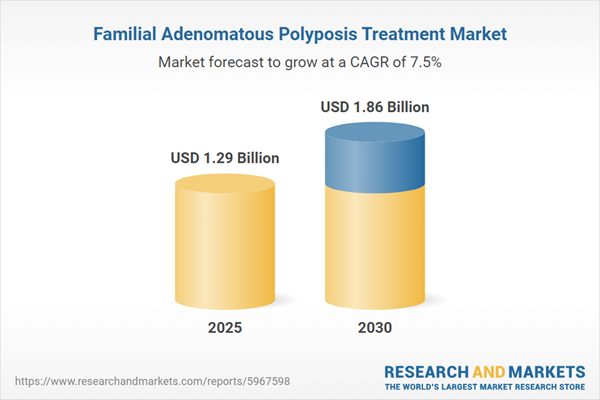Speak directly to the analyst to clarify any post sales queries you may have.
The Familial Adenomatous Polyposis Treatment Market is undergoing a pivotal transition as industry innovation, evolving care models, and complex reimbursement environments drive new opportunities and risks for senior healthcare decision-makers. Effective navigation of this landscape requires a clear, data-driven perspective focused on actionable strategies.
Market Snapshot: Familial Adenomatous Polyposis Treatment Market
The Familial Adenomatous Polyposis Treatment Market grew from USD 1.20 billion in 2024 to USD 1.29 billion in 2025. It is expected to continue growing at a CAGR of 7.47%, reaching USD 1.86 billion by 2030.
Key drivers include ongoing scientific advances in genetic diagnostics, targeted therapies, and minimally invasive procedures. Stakeholder collaboration across payers, clinicians, and advocacy organizations is shaping more patient-centric and cost-effective treatment models, while global policy efforts facilitate regulatory alignment for rare diseases.Scope & Segmentation
This comprehensive report delivers granular insights across geographical and therapeutic dimensions, enabling strategic leadership teams to benchmark growth and capitalize on emerging modalities.
- Treatment Types: Combination therapy, endoscopic surveillance (colonoscopy, sigmoidoscopy), pharmacologic therapy (biologics—gene therapy, monoclonal antibodies; nonsteroidal anti-inflammatory drugs—COX-2 inhibitors, nonselective NSAIDs), and surgical intervention (colectomy, ileorectal anastomosis, proctocolectomy).
- Routes of Administration: Intravenous, oral, subcutaneous.
- Distribution Channels: Hospital pharmacy, online pharmacy, retail pharmacy.
- End Users: Home care, hospitals, specialty clinics.
- Indications: Attenuated FAP, classic FAP.
- Geographic Regions: Americas (United States, Canada, Mexico, Brazil, Argentina, Chile, Colombia, Peru), Europe (United Kingdom, Germany, France, Russia, Italy, Spain, Netherlands, Sweden, Poland, Switzerland), Middle East (UAE, Saudi Arabia, Qatar, Turkey, Israel), Africa (South Africa, Nigeria, Egypt, Kenya), Asia-Pacific (China, India, Japan, Australia, South Korea, Indonesia, Thailand, Malaysia, Singapore, Taiwan).
- Key Companies: Ambry Genetics Corporation by Tempus Company, Eloxx Pharmaceuticals, Emtora Biosciences, KD Pharma Group, Biodexa Pharmaceuticals, Thermo Fisher Scientific, Labcorp Holdings, PreventionGenetics, Olympus Corporation, Panbela Therapeutics, FUJIFILM Holdings, Pentax Ricoh Imaging, Medtronic, Stryker, Recursion Pharmaceuticals, BGI Genomics, Siemens Healthcare, Eiken Chemical, Quest Diagnostics, Beckman Coulter, SENTINEL CH. SpA, QuidelOrtho, Illumina, 23andMe, Myriad Genetics, Bayer, Boston Scientific, CONMED, Cook Medical, Johnson & Johnson Services, Parabilis Medicines.
Key Takeaways
- Precision medicine and gene therapy are redefining treatment options, with monoclonal antibodies and next-generation biologics advancing clinical outcomes.
- Digital health integration—including AI-powered diagnostics and telemedicine solutions—is supporting risk stratification, remote patient management, and improved adherence.
- Post-pandemic supply chain volatility and regional tariff policies necessitate distributed manufacturing and resilient procurement strategies for critical biologics and devices.
- Segmentation by end user and indication enables tailored value propositions and targeted support programs, enhancing access and patient satisfaction across geographies.
- Strategic alliances and merger activity continue to shape the competitive landscape, driving the acceleration of clinical research and international product launches.
Tariff Impact
The 2025 revision of United States tariffs is impacting the cost structure for biologics, gene therapies, and specialized surgical instruments in the FAP ecosystem. Adjustments are leading manufacturers to consider localized production, robust scenario modeling, and logistics innovation to offset inventory pressure and customs delays. Advocacy groups are responding by prioritizing policy exemptions for essential therapies to prevent access barriers.
Methodology & Data Sources
This report is built on a rigorous multi-modal research design, synthesizing secondary data from regulatory filings, peer-reviewed journals, and industry reports with primary interviews from clinical experts, payers, and patient advocates. Quantitative and qualitative analyses are cross-validated and peer-reviewed, ensuring trustworthy, actionable findings for executive stakeholders.
Why This Report Matters
- Enables precise benchmarking across treatment types, technologies, and regions, supporting data-driven portfolio and market access decisions.
- Provides clarity on regulatory trends, tariff implications, and emerging digital health tools critical for sustainable operational and procurement planning.
- Uncovers strategic innovation and partnership pathways, helping leadership teams identify growth opportunities and mitigate future disruption.
Conclusion
Leaders navigating the Familial Adenomatous Polyposis Treatment Market will benefit from a holistic view of technology evolution, regulatory alignment, and dynamic patient needs. This report offers practical, forward-looking insights to support resilient, patient-centered growth strategies in a transforming landscape.
Additional Product Information:
- Purchase of this report includes 1 year online access with quarterly updates.
- This report can be updated on request. Please contact our Customer Experience team using the Ask a Question widget on our website.
Table of Contents
3. Executive Summary
4. Market Overview
7. Cumulative Impact of Artificial Intelligence 2025
Companies Mentioned
The companies profiled in this Familial Adenomatous Polyposis Treatment market report include:- Ambry Genetics Corporation by Tempus Company
- Eloxx Pharmaceuticals, Inc.
- Emtora Biosciences
- KD Pharma Group
- Biodexa Pharmaceuticals PLC
- Thermo Fisher Scientific Inc.
- Labcorp Holdings Inc.
- PreventionGenetics
- Olympus Corporation
- Panbela Therapeutics, Inc.
- FUJIFILM Holdings Corporation
- Pentax Ricoh Imaging Company, Ltd.
- Medtronic plc
- Stryker Corporation
- Recursion Pharmaceuticals, Inc.
- BGI Genomics Co., Ltd.
- Siemens Healthcare Private Limited
- Eiken Chemical Co., Ltd.
- Quest Diagnostics Incorporated
- Beckman Coulter, Inc.
- SENTINEL CH. SpA
- QuidelOrtho Corporation
- Illumina, Inc.
- 23andMe, Inc.
- Myriad Genetics, Inc.
- Bayer Corporation
- Boston Scientific Corporation
- CONMED Corporation
- Cook Medical LLC
- Johnson & Johnson Services, Inc.
- Parabilis Medicines
Table Information
| Report Attribute | Details |
|---|---|
| No. of Pages | 187 |
| Published | November 2025 |
| Forecast Period | 2025 - 2030 |
| Estimated Market Value ( USD | $ 1.29 Billion |
| Forecasted Market Value ( USD | $ 1.86 Billion |
| Compound Annual Growth Rate | 7.4% |
| Regions Covered | Global |
| No. of Companies Mentioned | 32 |









